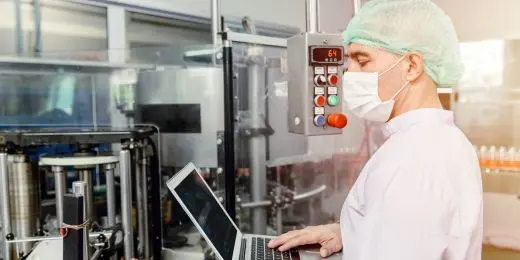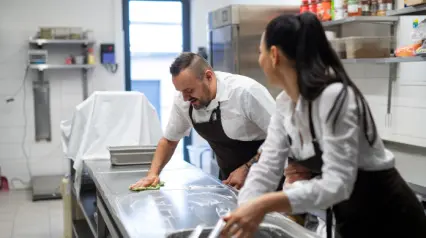What is Food Handling?
Food handling is the process of preparing food that is safe for public consumption. Essential to implementing safe food handling is that food handlers receive training on personal hygiene and sanitation, cooking and storing food at appropriate temperatures, and other safe food handling practices. An integral part of food safety, food handling should always be a priority.
Why is Food Handling Important?
Food handling is important because unsafe food handling can lead to outbreaks of foodborne illnesses (commonly known as food poisoning). According to the World Health Organization (WHO), foodborne illnesses can cause long-lasting disability and even death.
As a possible threat to public health and safety, food handling is closely monitored by government agencies across the world. Failing to pass routine inspections and not complying with regulations can result in involuntary shutdowns of businesses.
On the other hand, food service businesses that are consistent in following safe food handling practices may actively prevent cases of foodborne illness and gain the trust of their customers as a result. Additionally, these businesses avoid the chance of non-compliance with regulations and form better relationships with the local authorities and business partners in their areas of operation.
Food Handling Regulations
In the United States, under the Food and Drug Administration (FDA) Food Code 2017, permit holders or those who operate food establishments must assign someone or take responsibility as the person in charge. The person in charge has to ensure that employees are maintaining the correct temperatures during cooking, cooling, and holding. This works with the Hazard Analysis and Risk-based Preventive Control (HARPC), a regulation under the Food and Drug Administration’s FSMA (Food Safety Modernization Act).
In Australia, according to the Food Standards Code, it’s the duty of food businesses to make sure that food handlers are trained and knowledgeable about food safety and food hygiene. Food businesses must also take the necessary steps to prevent the likelihood of food being contaminated. The recently updated Standard 3.2.2A which must be followed starting December 2023 states that all food businesses that operate as food service establishments, caterers, or related retailers must ensure that all employees who handle food have proper food handler training to ensure that they have adequate knowledge and skills before they start preparing high-risk foods.
Consequences of Bad Food Handling
On June 9, 2021, it was reported by the public health department of King County in Washington that 13 people who dined at a certain restaurant were sick with norovirus, a kind of foodborne illness. According to Medical News Today, norovirus infections are caused by touching a contaminated surface or by consuming contaminated food.
The last inspection of the restaurant before investigation showed that it had failed to observe several safe food handling practices which could have prevented the outbreak, such as:
- Maintaining proper barriers to prevent bare hand contact with ready-to-eat food
- Keeping nonfood contact surfaces maintained and clean
- Properly using, storing, and sanitizing wiping cloths
Aside from putting the lives of people at risk, bad food handling also has long-term legal implications, as seen with Blue Bell Creameries. In 2015, a deadly Listeria outbreak was traced back to the company’s ice cream. As a result, Blue Bell had to settle its criminal liability with the Department of Justice in payments of $19.35 million.
In 2017, the company was sued by shareholders for misconduct leading to the recall of its products and reached a $60 million settlement with them in 2020. In 2021, Blue Bell is facing a lawsuit filed by its insurance carriers for failing to maintain standards and controls for sanitary and safe production.
Create your own Food Safety checklist
Build from scratch or choose from our collection of free, ready-to-download, and customizable templates.
Browse Food Safety checklistsWhat are Safe Food Handling Practices?

Often referred to as the 4 steps to food safety, the core safe food handling practices are clean, separate, cook, and chill. Each safe food handling practice will be discussed in detail below for dairy, meat and fish, eggs, fruit and vegetables, frozen goods, and dried goods.
1. Clean
Food handlers must always wash their hands before they begin food preparation. The key tip for handwashing is to use warm water and regular soap. Handwashing should last for at least 20 seconds. Aside from keeping their hands and arms clean, food handlers must also ensure that the tools they’ll be using for food preparation, such as cutting boards, knives, pans, and spatulas, are clean and dry.
2. Separate
Raw meat, poultry, seafood, and eggs should always be kept separate from other ingredients. Don’t use containers, plates, or cutting boards that have held raw meat, poultry, seafood, or eggs for other ingredients, unless they have been washed in hot soapy water. The same rule applies to utensils.
3. Cook
Once they have finished cooking a dish, food handlers are required to check its internal temperature by using a food thermometer. There are specific internal temperature ranges for each food type. Food handlers must not send food out for serving if it is not within the required temperature range. This is to ensure that all harmful microorganisms are killed before the plate reaches the customer.
4. Chill
Keep the temperature within the refrigerator below 40°F (4°C). To avoid having to manually check the temperature using an appliance thermometer several times throughout the day, consider setting up temperature sensors for ease of mind. These sensors can also alert food handlers when fridge temperature reaches or starts to go above 40°F (4°C). For freezers, the recommended temperature is 0°F (-17°C).
Improve your EHS Management
Cultivate a safe working environment and streamline compliance with our EHS solutions.
Explore nowFood Handling Practices for Dairy
- Do not purchase, use, or serve dairy products containing unpasteurized milk, except for hard cheeses that have been aged 60 days.
- Do not return milk and other dairy products to their original containers once taken out.
- In general, milk, cream, yogurt, and cheese should be kept chilled in the refrigerator at a temperature below 40°F (4°C).
- Unopened shelf-stable milk, such as evaporated, condensed, and Ultra-High Temperature (UHT) milk, can be stored at room temperature. However, once opened, shelf-stable milk should be kept chilled in the refrigerator at a temperature below 40°F (4°C).
- Butter can be kept in the refrigerator at a temperature below 40°F (4°C) for a maximum of 2 weeks. Past 2 weeks, it must be wrapped in packaging, then kept in a freezer at or below 0°F (-17°C). For use in dessert batters, butter must be at room temperature or approximately 71°F (22°C).
- Ice cream should be kept in a freezer at or below 0°F (-17°C).
- Do not freeze yogurt, cream, or milk except for fresh whole or skimmed milk.
- If mold is visible on hard cheese, cut out the part with mold and the area surrounding it. Examples of hard cheeses are cheddar, Swiss, Gouda, and Parmesan.
- If mold is visible on soft cheese (excluding blue cheese), discard the cheese. Examples of soft cheeses are Brie, feta, ricotta, and cottage cheese.
Food Handling Practices for Meat and Fish
- Don’t wash meat, poultry, or seafood.
- If meat or poultry will be defrosted using a microwave, cook immediately after defrosting.
- Keep the original packaging of meat and poultry or seal it in an airtight, leak-proof bag before thawing in cold water. Change the cold water every 30 minutes.
- Do not use a slow cooker to cook frozen meat or poultry.
- Only marinate meat in the refrigerator.
- Ground meat should be cooked at 160°F (72°C) or higher.
- Beef, pork (including uncooked ham, both fresh and smoked), veal, and lamb should be cooked at 145°F (63°C) or higher and should be left to rest for 3 minutes before serving.
- Poultry (whether whole, in parts, or ground, and including stuffing) should be cooked at 165°F (74°C) or higher.
- Fish should be cooked at 145°F (63°C) or higher. Another way to determine if fish has been sufficiently cooked is to check if the flesh is opaque and separates easily when using a fork.
- Shrimp, lobster, and crabs are sufficiently cooked when their flesh is pearly and opaque.
- Scallops are sufficiently cooked when their flesh is milky white or opaque and firm.
- Clams, oysters, and mussels are sufficiently cooked when their shells open.
Food Handling Practices for Eggs
- Don’t wash eggs.
- Separate raw (unpasteurized) eggs from pasteurized eggs.
- Damaged eggs should be discarded.
- Eggs should be kept in the refrigerator at a temperature below 40°F (4°C).
- Before use in dessert batters, eggs should be at room temperature.
- Eggs should be cooked until the yolk and white are firm. The recommended cooking temperature is 250°F (121°C).
- Dishes containing eggs should have an internal temperature of 160°F (72°C) or higher.
Food Handling Practices for Fruit and Vegetables
- Cut away damaged or bruised areas.
- Rinse fruits and vegetables under running water before preparation even if there is an outer peel that will be discarded. Don’t use soap or any other cleansing agent.
- Do not wash fruits and vegetables that have been labeled as pre-washed by the manufacturer.
Food Handling Practices for Frozen Goods
- Discard the parts of food that have freezer burn.
- Don’t leave frozen goods out to thaw. Only thaw in refrigerators, cold water, or through the use of a microwave.
- If food has not been thawed properly, do not refreeze it.
- Always thoroughly cook frozen food.
- Do not freeze canned food and eggs in shells.
- Avoid freezing mayonnaise, cream sauce, and lettuce.
- Avoid freezing items at the end of their shelf life. If possible, freeze food when it is at its highest quality.
- Before freezing, briefly place vegetables in boiling water and then put them in iced water or under cool running water to blanche.
Food Handling Practices for Dried Goods
- Check dried goods for insects and pests, especially weevils which can quickly cause a widespread infestation.
- Store dried goods at temperatures between 50°F to 70°F (10°C to 21°C) in a well-ventilated area away from sunlight.
- Do not use cardboard boxes to store dried goods. Use airtight containers.
- Keep dried goods at least 6 inches (15 centimetres) from the floor.
- Keep humidity levels as low as possible. Humidity levels should not exceed 55%. Use a humidity sensor if needed.
Other Food Handling Guidelines
- When reheating food for hot holding, all parts of the food should reach a minimum internal temperature of at least 165°F (74°C).
- Cool cooked food within 2 hours from 135°F to 70°F (57°C to 21°C) or within 6 hours from 135°F to 41°F (57°C to 5°C).
- For hot holding, temperature should be maintained at 135°F (57°C) or above.
- For cold holding, temperature should be maintained at 41°F (5°C) or below.
A New Way to Handle Food
SafetyCulture is a digital operations platform that has helped food service businesses such as Marley Spoon, Snooze Eatery, The Dinner Ladies, and more in safe food handling.
Integrate with Sensors
Together with the mobile app, SafetyCulture sensors are powerful tools that bring ease of mind to food safety managers and food handlers. Receive an alert whenever sensors detect that temperature or other factors have gone out of acceptable range. SafetyCulture sensors also have no IT requirements and can be set up in minutes. Simply unbox your sensors and stick them in the fridge.
SafetyCulture can also connect to existing sensors, enabling you to take charge of your data and monitor conditions more seamlessly.
Gain 24/7 Real-Time Visibility
SafetyCulture enables food handlers at different locations to capture data on the spot. By adding photos or notes of what needs to be fixed or of what can be improved, food handlers can document valuable information for food safety managers to see in real-time.
With food service, fast action is not just recommended, it’s required. Get better visibility of operations and automate notifications in order to resolve issues quickly regardless of location with SafetyCulture.
Feel the Power of Digitized Checks
Unlike paper-based processes which are inconsistent, vague, and difficult to organize, digitized checks record every little detail, storing them in a single, secure location for you and your team to access at any time of the day. As those in the food service industry know, consistent quality is key to customer satisfaction.
Deploy a Food Handling Course to Comply with Safety Standards
Whether you’re a food supplier, manufacturer, or food business owner, protecting your customers from foodborne illnesses, allergies, and poisoning should always be the number one priority. Any food handling oversights or lack of preparation can result in huge business losses, which can come in the form of fines, lawsuits, rejected products, or business closure. Being able to implement food safety practices requires knowledge about food contaminants that can affect any part of the food supply chain. These contaminations are usually caused by biological, chemical, and physical hazards so it’s important to know proper food handling applications to avoid such incidents. Some of the most important food handling practices include maintaining proper food hygiene, segregating food to avoid cross-contamination, storing food at the correct refrigerator temperatures, and cooking at the right internal temperatures to prevent serving undercooked food.
As a business, one of the best ways you can promote these food safety practices is by distributing a comprehensive food handling course to your employees. These courses typically cover topics such as food safety standards, delivery and storage processes, food prep, food contamination, and food-borne illnesses, all of which are vital for food handlers to understand.
Food Handling FAQs
The type of hazard most commonly associated with food handling is microbiological. Microbiological hazards are bacteria, viruses, parasites, and prions. The top 3 sources of microbiological hazards in food are raw (unpasteurized) milk, contaminated fruits and vegetables, and raw or undercooked meat and seafood. Use a HACCP plan to efficiently identify and control microbiological hazards and prevent cases of foodborne illness.
In the establishment, the person in charge, who may be the owner or someone designated by the owner, is responsible for training food handlers in safe food handling practices. To train food workers, persons in charge can use Training by SafetyCulture (formerly iAuditor) to ensure that everyone in the establishment or organization is aware of all necessary food handling and safety practices.
To get started, Training offers the following food handling training courses:
The nutrients in foods that are most vulnerable to losses during food handling and preparation are water-soluble vitamins, which are B-complex vitamins and vitamin C. The B-complex vitamins most affected by food preparation are folate and thiamine. As a folate-rich food, vegetables are the most vulnerable to nutrient losses during food handling.



